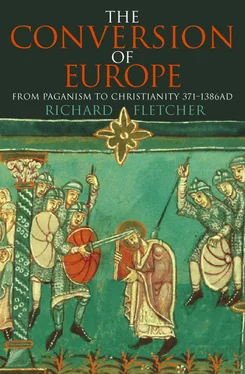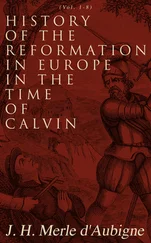Martin’s successors as bishops of Tours carried on the work he had started of building churches at rural settlements in the diocese. Brice, Martin’s first and very long-lived successor (bishop 397–444) built five; Eustochius (444–61), four; Perpetuus (461–91), six; Volusianus (491–8), two. We know of these because they were listed, like Martin’s, by Gregory of Tours towards the end of the sixth century. Gregory did not list these churches out of mere antiquarian interest: he listed them because they were episcopal foundations, the network through which the bishop supervised his diocese. What he does not tell us about, because he had no interest in so doing, was the progress of church-building by laymen on their own lands; estate (or villa ) churches built by landowners for their own households and dependants. We hear about such churches only by chance. For example, Gregory introduces a story about the relics of St Nicetius of Lyons with the information that he, Gregory, had been asked to consecrate a church at Pernay. In another of his works we learn that it had been built by a certain Litomer, presumably the lord of the estate. Litomer must have been building his church at Pernay in the 580s. By that date Touraine was fairly densely dotted with churches. It has been plausibly estimated that by Gregory’s day most people in the diocese would have had a church within about six miles of their homes.
It must be emphasized that Touraine is a very special case as regards the extent of our information about it. Thanks to Gregory’s writings we know more about the ecclesiastical organization of the diocese of Tours than we do about any other rural area of comparable size in fourth-, fifth- or sixth-century Christendom. We should never have guessed that there was a church at the little village of Ceyreste, between Marseilles and Toulon, had its control not been disputed between the bishops of Arles and Marseilles: the dispute elicited a papal ruling in 417, the source of our knowledge. We hear about the church at Alise-Sainte-Reine, about ten miles from the ruined shrine of Dea Sequana, only because when St Germanus of Auxerre stayed a night there with its priest in about 430 the straw pallet on which he had slept was found to possess miraculous curative properties: his hagiographer Constantius recorded the fact and thus preserved the notice of the church. It is from the Vita Eugendi that we hear of the existence of a church at Izernore, between Bourg-en-Bresse and Geneva, and from the Vita Genovefae that we hear of a church at Nanterre, then about seven miles from Paris; both of these from the second quarter of the fifth century. At Arlon in Belgium, close to the modern borders with both Luxembourg and France, archaeologists have excavated what might have been a church of the late Roman period: caution is necessary because excavated church buildings from this period are difficult to identify as such. We know that Bishop Rusticus of Narbonne consecrated a new church at Minerve, which has given its name to the wine-growing district of Minervois, in 456 because an inscription recording the fact has survived. At Chantelle, near Vichy, a landowner called Germanicus built a church in the 470s: it is referred to in one of the letters of Sidonius Apollinaris, bishop of Clermont.
We hear of these churches because of the chance survival of a legal ruling, three pieces of hagiography, the buried foundations of a building, an inscription and a bishop’s letter-collection. It is a ragbag of odds and ends of evidence, some of them of rather doubtful status, characteristic of the coin in which the early medieval historian has to deal. So slender are the threads by which our knowledge hangs, so fragmentary and isolated its separate pieces, that we have to exercise the utmost caution in teasing out what it might have to tell us. To the question, How far may we press our evidence? different historians will give different answers. How representative was Touraine in respect of the building of churches? To what degree, if at all, may we generalize from its circumstances? Were the dioceses of Arles or Auxerre or Paris or Narbonne or Clermont as well provided with rural churches by the year 600 as was the diocese of Tours? These are – given our sources, these have to be – open questions. The reader is free to speculate.
We rarely know anything at all of the precise circumstances which brought any individual rural church into being. Here is an example, deservedly famous, of a case where we do know something: it also shows that not all bishops were as violently confrontational in their methods as Martin was.
In the territory of Javols [on the western edge of the Massif Central] there was a large lake. At a fixed time a crowd of rustics went there and, as if offering libations to the lake, threw into it linen cloths and garments, pelts of wool, models of cheese and wax and bread, each according to his means. They came with their wagons; they brought food and drink, sacrificed animals, and feasted for three days. Much later a cleric from that same city [Javols] became bishop and went to the place. He preached to the crowds that they should cease this behaviour lest they be consumed by the wrath of heaven. But their coarse rusticity rejected his teachings. Then, with the inspiration of the Divinity this bishop of God built a church in honour of the blessed Hilary of Poitiers [Martin’s patron] at a distance from the banks of the lake. He placed relics of Hilary in the church and said to the people: ‘Do not, my sons, sin before God! For there is no religious piety to a lake. Do not stain your hearts with these empty rituals, but rather acknowledge God and direct your devotion to His friends. Respect St Hilary, a bishop of God whose relics are located here. For he can serve as your intercessor for the mercy of the Lord.’ The men were stung in their hearts and converted. They left the lake and brought everything they usually threw into it to the holy church instead. So they were freed from the mistake that had bound them. 6
This shrewd manoeuvre by the unnamed bishop of Javols probably occurred in about the year 500. It is a fine example of a technique of rural evangelization which became classic: the transference of ritual from one religious loyalty to another. Gregory of Tours, reporting the story, plainly thought that the bishop had thereby made his lakeside flock more Christian. Perhaps he had.
There is a further layer of interest in the story of the sacred lake of Javols. The episode demonstrates the local standing and authority of the bishop; it may have enhanced them too. We saw some signs of the beginnings of a change in the nature of a bishop’s public role in the career of Gregory of Pontus. Change was accelerated in the wake of Constantine’s conversion. Further impetus was given in the western provinces of the empire in the course of the fifth and sixth centuries. It was during this age that the last tatters of central imperial control were shaken from Britain, Gaul and Spain. As the distinctive marks of functioning Romanitas were whittled away – especially the army and the civil service and their economic underpinning – so bishops tended to become the natural leaders of their local communities.
Let one instance stand for many: Germanus of Auxerre, as presented in the biography by Constantius of Lyons composed about forty years after its subject’s death. 7 Germanus, born in about 378, was a member of an aristocratic family of the Auxerrois who received a good education in Gaul and at Rome, married suitably, practised successfully as a lawyer and achieved high public office as governor of Armorica, the north-western region of Gaul. When the bishopric of Auxerre fell vacant in 418 Germanus was plucked from this entirely secular career by the Christian community of Auxerre, who insisted that he must be their next bishop. Constantius had read his Sulpicius Severus and knew how an episcopal biographer should present his subject to an admiring world. So we hear a good deal about Germanus’ austerities, virtues, miracles and so forth. Hence the story about the straw at Alise which seems to have been modelled in characteristically hagiographical fashion on a story told of Martin by Sulpicius. But we also hear from Constantius about the part played by Germanus in public affairs. He protected the people of Auxerre from a crushing burden of taxation. He restrained Goar, king of the barbarian Alans, from ravaging Armorica. He went to Britain to quell heresy and while there led a British army to victory over marauding Picts and Saxons. He interceded with the imperial court at Ravenna on behalf of the province of Armorica.
Читать дальше












